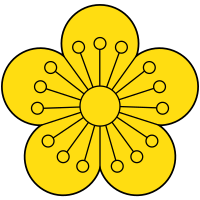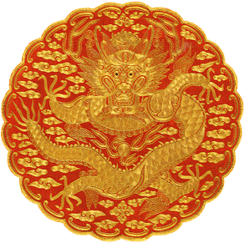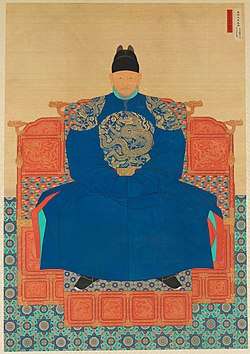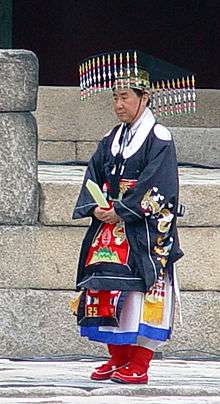House of Yi
The House of Yi or Korean Royal Household, also called the Yi dynasty or known as Jeonju Yi clan, is the household of Joseon and the Korean Empire, consisting of the descendants of Yi Seong-gye, the founder of Joseon, known by his temple name, Taejo (태조; 太祖; "grand progenitor"). All his descendants are members of the Yi clan of Jeonju, including the imperial family of the Korean Empire (1897–1910).
| House of Yi | |
|---|---|
  | |
| Parent house | Jeonju Yi clan |
| Country | |
| Founded | 17 July 1392 – Joseon's founding |
| Founder | Taejo of Joseon |
| Final ruler | Sunjong of Korea |
| Titles | |
| Religion | Confucianism (state ideology) Korean Buddhism Taoism Shamanism |
| Deposition | 1910 – Japan–Korea Treaty of 1910 |
| Cadet branches | 125 cadet branches (approximately 105 extant) including:
|
After the Japan–Korea Treaty of 1910, in which the Empire of Japan annexed the Korean Peninsula, some members of the Jeonju Yi clan were mediatised into the Imperial House of Japan and the Japanese peerage by the Japanese government[1] until 1947, just before the Constitution of Japan was promulgated.[2] Under the 11th Article of the Constitution of South Korea, the Korean government does not acknowledge any form of privileged caste since its promulgation in 1948.[3][4]
However, with the Constitution succeeding to the Provisional Government,[5] the descendants from the Imperial Family continues to exist as a favored symbol and attracts media attention in South Korea. This happened most recently with the July 2005 funeral of Yi Gu, former head of the royal household, in addition to Yi Seok in the 100th anniversary of Korean independence[6] on March 1, 2019.
History
Early Era (15th century)

When Taejo of Joseon ascended to the throne in 1392, he remained adopting the laws of Goryeo, the noble titles he gave to his sons, nephews, son-in-laws were all "prince" (군).[7] After the coup d'état in 1398, the system of noble titles changed: "duke" for king's sons, "marquis" for royal descendants, and "earl" for officers of senior first rank;[8] only to be abolished in 1401 to not to "usurp" the existing laws in the Ming dynasty.[9] As of 1412, Taejong of Joseon approved a new system for giving titles to the royalty:[10] among the sons of a king, those who were born by the queen can acquire the title "grand prince" (대군), and the rest can be the "prince" (군); both princes have are of senior first rank and their male descendants as far as their great-grandsons can retrieve official positions as well. According to the Veritable Records of the Joseon Dynasty, the title "prince" (군) was at first restricted to be given to sons or grandsons of kings, but the standards of which became looser over time.[11][12] Generally, a royalty eligible to be a prince couldn't receive the title automatically even one's rank raises to the junior second rank;[13] and such a hereditary title could be passed down to generations until it exceeds over four generations (from the king).[14]
Similar to male royalties, female royalties received titles according to their kinship to the kings. Despite all called "princess" in English, daughters of king and queen were called 공주 (gongju) and those were born by other consorts were called 옹주 (ongju) to differentiate; some further distant female royalties also had different titles.[15][16] If the above mentioned females were stripped of titles due to various reasons, they would be referred as wife of "their spouses"; for instance, the eldest daughter of deposed Yeonsangun of Joseon were called "Ku Mun-gyeong's wife" after 1506.[17] Later, there were also so-called "Kim Se-ryung's wife" (former Princess Hyomyeong) and "Jeong's wife" (former Princess Hwawan).[18][19]
Middle Era
In 1469, Seongjong of Joseon ascended to the throne as the adopted heir to his uncle, Yejong of Joseon. As of 1475, Seongjong asked the Ming dynasty government to ratify his biological father, Crown Prince Uigyeong, to have a posthumous status as a king,[20] and a posthumous name "Deokjong" was made for the late crown prince.[21] Similar thing happened in 1568, when Seonjo of Joseon succeeded the throne as the adopted heir to his half-uncle, Myeongjong of Joseon; due to the advice from officials, instead of conferring his biological father (Prince Deokheung) a title of "king" posthumously, Seonjo created him a new title, Deokheung Daewongun (덕흥대원군), as an honor to the late prince in 1569. This was referenced from an precedent in 1066, about Emperor Yingzong of Song, who promoted his biological father (Zhao Yunrang) without posthumously elevating him to the status of emperor.[22][23] Following the precedent from Seonjo, there are three more royalties becoming Daewongun throughout the Joseon history: Prince Jeongwon (1623, but later promoted to "King Wonjong" as of 1634"),[24][25] Yi Kwang (Jeongye Daewongun, 1849),[26] and Prince Heungseon (1863).[27]
In 1650, Hyojong of Joseon, requested by the prince regent Dorgon of the Qing dynasty, adopted a fifth cousin once removed as his daughter and exceptionally made her Princess Uisun, and she became the new bride of Dorgon.[28]
Gojong and Sunjong (1863-1910)

Japan, after the Meiji Restoration, acquired Western military technology, and forced Joseon to sign the Japan–Korea Treaty of 1876 after the Ganghwa Island incident. It established a strong economic presence on the peninsula, heralding the beginning of Japanese imperial expansion in East Asia. In the 19th century tensions mounted between China and Japan, culminating in the First Sino-Japanese War, much of this war was fought on the Korean Peninsula. The Chinese defeat in the 1894 war led to the Treaty of Shimonoseki, which officially guaranteed Korea's independence from China. The treaty effectively granted Japan direct control over Korean politics.
The Joseon court, pressured by encroachment from larger powers, felt the need to reinforce national integrity and declared the Korean Empire in 1897. King Gojong of Korea assumed the title of Emperor in order to assert Korea's independence by putting himself on the same level as the Chinese and Japanese Emperors. In addition, other foreign powers were approached for military technology, especially Russia, in order to fend off the Japanese. Technically, 1895 marks the end of the Joseon period, as the official name of the state was changed; however, the dynasty continued, albeit perturbed by Japanese interventions. For example, the 1895 assassination of the emperor's consort, Queen Min,[29] apparently orchestrated by Japanese general Miura Gorō because the Korean empress was effective in keeping Japan at bay.
As an emperor, Gojong granted higher titles to some of his close relatives, and so did his successor Sunjong of Korea. In 1900, Gojong's younger sons, Yi Kang, became Prince Imperial Ui (의친왕) while Yi Un became Prince Imperial Yeong (영친왕),[30] and Yi Seon, their older half brother who died young in 1880, posthumously became Prince Imperial Wan (완친왕) in 1907.[31] And finally, Yi Jae-myeon, Gojong's (biological) elder brother became Prince Imperial Heung (흥친왕) in 1910.[32]
After a long-term process of controlling the puppet state, on 22 August 1910, the Japanese annexation of the Korean peninsula effectively ended rule by the House of Yi as the Japan–Korea Treaty of 1910 was made. According to the treaty, some of the members of Yi family were mediatised into the royal family (王公族, Ōkōzoku) or made Korean nobles (朝鮮貴族, Chōsen-kizoku).[33][34][35]
The Korean nobility titles granted by Japan in 1910, if only listing those who came from Jeonju Yi clan, are as follows:
| The Royal Family and Yi Korean Nobles in 1910 | |||||||||
|---|---|---|---|---|---|---|---|---|---|
| Category | Empire of Japan | Korean Empire | Notes | ||||||
| Title | Name | Title | Belong to cadet branch | Genealogy | Years of birth and death | ||||
| King Yi family | King Emeritus Yi of Deoksu | Yi Hui | Emperor Emeritus (Gojong) |
- |
|
1852-1919 | |||
| King Yi of Changdeok | Yi Cheok | Emperor (Sunjong) |
- |
|
1874-1926 | ||||
| Crown Prince of King Yi | Yi Un | Imperial Crown Prince | - |
|
1897-1970 | ||||
| Duke Yi | Duke Yi Kang | Yi Kang | Prince Imperial Ui | - |
|
1877-1955 | |||
| Duke Yi Hui | Yi Jae-myeon | Prince Imperial Heung | House of Prince Yeonryeong |
|
1845-1912 | ||||
| Korean Nobles | Marquess | Yi Hae-seung | Prince Cheongpung | House of Prince Euneon | 1890-? | ||||
| Yi Jae-gak | Prince Uiyang | House of Prince Eunjeon |
|
1874-1935 | |||||
| Yi Jae-wan | Prince Wansun | House of Prince Yeonryeong |
|
1856-1922 | |||||
| Yi Hae-chang | Prince Changsan | House of Deokheung Daewongun |
|
1865-1945 | |||||
| Count | Yi Ji-yong | - | House of Prince Yeonryeong |
|
1870-1928 | ||||
| Viscount | Yi Byeong-mu | - | House of Prince Murim |
|
1864-1926 | ||||
| Yi Wan-yong | - | House of Prince Euneon |
|
1872-1937 | |||||
| Yi Gi-yong | - | House of Prince Yeonryeong | 1889-1961 | ||||||
| Yi Jae-gon | - | House of Prince Gyeongchang |
|
1859-1943 | |||||
| Yi Geun-taek | - | House of Prince Gyeongmyeong |
|
1865-1919 | |||||
| Baron | Yi Jong-geon | - | House of Prince Murim |
|
1843-1930 | ||||
| Yi Bong-ui | - | House of Grand Prince Hyoryeong |
|
1839-1919 | |||||
| Yi Jae-geuk | - | House of Grand Prince Neungchang | 1864-1931 | ||||||
| Yi Geun-ho | - | House of Prince Gyeongmyeong |
|
1860-1923 | |||||
| Yi Geun-sang | - | House of Prince Gyeongmyeong |
|
1874-1920 | |||||
| Yi Yong-tae | - | House of Prince Milseong |
|
1854-1922 | |||||
| Yi Yong-won | - | House of Prince Milseong |
|
1832-1911 | |||||
| Yi Geon-ha | - | House of Grand Prince Muan |
|
1835-1913 | |||||
Japanese colonial rule and Post-liberation

Emperor Gojong had nine sons and four daughters, but only three princes, as well as one princess: the second son, Crown Prince Cheok; the sixth son, Yi Kang, and the seventh son, Yi Un. The second son, Cheok, became Emperor Sunjong, the last monarch of the Korean Empire. Since Emperor Sunjong died without issue, his younger brother, Yi Un, the Prince Imperial Yeong became the Imperial Crown Prince. His elder brother, Yi Kang (Prince Imperial Ui), should have taken the position, but was passed over - due to the low status of Yi Kang's biological mother, Lady Chang, as well as the notorious fame of Yi Kang himself known not only domestically but also internationally.[51]
After Emperor Sunjong died in 1926, Crown Prince Yi Un was called "King Yi", a nominal title because the country had already lost its sovereignty to Japan. Yi Un married a Japanese princess, Princess Masako of Nashimoto, who was later known as Yi Bangja, a member of the Miyake cadet family. After they married, Princess Masako gave birth to Yi Jin in 1921 (died young) and Yi Ku in 1931.
After Korea's liberation in 1945, President Syngman Rhee suppressed the imperial family, in order to prevent the restoration of the monarchy, as he feared that its return would challenge his emerging authority as the new republic's founding father. Rhee seized and nationalized most of the family's properties, and the imperial family also had to shoulder the psychological and historical burden of their ancestors' responsibility for the "collapse of the nation". Stripped of most of their wealth and authority, some fled to the United States and Latin America, known descendants reside in New Jersey and New York. Meanwhile, the Jeonju Lee Royal Family Association was founded in 1957 and the members consist of the descendants of the royal family.[52] It was only in 1963 that a new president, Park Chung-hee, allowed the imperial family, including Princess Deokhye, to return to Korea. However, they could only stay at Nakseon Hall, a small residence in a corner of Changdeokgung in Seoul. Yi Un died seven years later after a long illness resulting from strokes. Yi Ku was forced by other family members to divorce his American wife, Julia Mullock, in 1982 due to her sterility (the couple, however, had an adopted daughter). A series of business failures left Yi Ku out of support, and he died alone at the Grand Prince Hotel Akasaka in Tokyo on July 16, 2005. The site of the hotel had been his birthplace 74 years prior.
Emperor Gojong's sixth son, Yi Kang (Prince Imperial Ui), fathered 13 sons and 9 daughters by 14 mistresses. With an extremely wide range of historical evaluations over him —womanizer, as well as a behind-the-scene leader of the independence movement — the Japanese authorities limited the activities of the prince throughout the occupation. President Syngman Rhee's seizure of the imperial properties deprived the prince of most of his wealth. According to the prince's 11th son, Yi Seok, his mother, Hong Chongsun, was forced to sell noodles as a street vendor to make a living. In 1998, it was reported that Yi Kang's eighth son died alone in a social center in eastern Seoul. The eleventh son, Prince Seok, is a lecturer at the Jeonju University as of 2005. Among Prince Yi Kang's surviving four sons and seven daughters, four lost touch with the family after they left for the United States. The other family members hold an ancestral ritual two times a year for Prince Kang, but usually only two or three of the 11 surviving siblings attend the ceremonies. Amy Yi (Yi Haegyeong), the fifth daughter of Yi Kang, migrated to the United States in 1956 and worked for 27 years as a librarian at Columbia University in New York City.[53] In September, 2012, she was 82 years old and described as "one of the last survivors of the Korean royal court".[53]
21st century
After the death of Yi Ku on 16 July 2005, a dispute about the head of the royal family occurred.
According to the Jeonju Lee Royal Family Association,[55][56] the last meeting, on July 10, was made between the association and Yi Ku, who allowed Yi Won, his first cousin once removed (grandson of Prince Yi Kang and his father is Yi Gap, 9th son of Yi Kang), to be his heir, and he signed as the proof of his permission, through the process of traditional adoption to his line. Yi Ku had met Yi Won several times before the adoption, satisfied about his foreign language abilities, and Yi Won was therefore chosen to be his successor and the status was confirmed by the association as of 22 July 2005.[57][58] Although, the adoption would be invalid by present Korean Law because Yi Ku died before the adoption process could complete.[59]
Yi Hae-won, second daughter of Yi Kang and a half-aunt of Yi Won, made a counter-claim as the "Empress of Korea" in a private ceremony organized by her followers in a hotel room.[60] She was enthroned as symbolic monarch of Korea on 29 September 2006 by the "Korean Imperial Family Association", organized by several descendants of Joseon Dynasty. She laid claim to the title of Empress of Korea and declared the restoration of Imperial House in her own succession ceremony in a hotel room.[60] The private enthronement was not approved or supported by Korean politics.[59] Yi Hae-won eventually died in 8 February 2020, aged 100.[61]
American Internet entrepreneur Andrew Lee, accepted a nomination by Yi Seok, on 6 October 2018, to become a "Crown Prince".[62][63]
House of Yi family tree
| House of Yi/Joseon Kings family tree | |||||||||||||||||||||||||||||||||||||||||||||||||||||||||||||||||||||||||||||||||||||||||||||||||||||||||||||||||||||||||||||||||||||||||||||||||||||||||||||||||||||||||||||||||||||||||||||||||||||||||||||||||||||||||||||||||||||||||||||||||||||||||||||||||||||||||||||||||||||||||||||||||||||||||||||||||||||||||||||||||||||||||||||||||||||||||||||||||||||||||||||||||||||||||||||||||||||||||||||||||||||||||||||||||||||||||||||||||||||||||||||||||||||||||||||||||||||||||||||||||||||||||||||||||||||||||||||||||||||||||||||||||||||||||||||||||||||||||||||||||||||||||||||||||||||||||||||||||||||||||||||||||||||||||||||||||||||||||||||||||||||||||||||||||||||||||||||||||||||||||||||||||||||||||||||||||||||||||||||||||||||||||||||||||||||||||||||||||||||||||||||||||||||||||||||||||||||||||||||||||||||||||||||||||||||||||||||||||||||||||||||||||||||||||||||||||||||||||||||||||||||||||||||||||||||||||||||||||||||||||||||||||||||||||||||||||||||||||||||||||||||||||||||||||||||||||||||||||||||||
|---|---|---|---|---|---|---|---|---|---|---|---|---|---|---|---|---|---|---|---|---|---|---|---|---|---|---|---|---|---|---|---|---|---|---|---|---|---|---|---|---|---|---|---|---|---|---|---|---|---|---|---|---|---|---|---|---|---|---|---|---|---|---|---|---|---|---|---|---|---|---|---|---|---|---|---|---|---|---|---|---|---|---|---|---|---|---|---|---|---|---|---|---|---|---|---|---|---|---|---|---|---|---|---|---|---|---|---|---|---|---|---|---|---|---|---|---|---|---|---|---|---|---|---|---|---|---|---|---|---|---|---|---|---|---|---|---|---|---|---|---|---|---|---|---|---|---|---|---|---|---|---|---|---|---|---|---|---|---|---|---|---|---|---|---|---|---|---|---|---|---|---|---|---|---|---|---|---|---|---|---|---|---|---|---|---|---|---|---|---|---|---|---|---|---|---|---|---|---|---|---|---|---|---|---|---|---|---|---|---|---|---|---|---|---|---|---|---|---|---|---|---|---|---|---|---|---|---|---|---|---|---|---|---|---|---|---|---|---|---|---|---|---|---|---|---|---|---|---|---|---|---|---|---|---|---|---|---|---|---|---|---|---|---|---|---|---|---|---|---|---|---|---|---|---|---|---|---|---|---|---|---|---|---|---|---|---|---|---|---|---|---|---|---|---|---|---|---|---|---|---|---|---|---|---|---|---|---|---|---|---|---|---|---|---|---|---|---|---|---|---|---|---|---|---|---|---|---|---|---|---|---|---|---|---|---|---|---|---|---|---|---|---|---|---|---|---|---|---|---|---|---|---|---|---|---|---|---|---|---|---|---|---|---|---|---|---|---|---|---|---|---|---|---|---|---|---|---|---|---|---|---|---|---|---|---|---|---|---|---|---|---|---|---|---|---|---|---|---|---|---|---|---|---|---|---|---|---|---|---|---|---|---|---|---|---|---|---|---|---|---|---|---|---|---|---|---|---|---|---|---|---|---|---|---|---|---|---|---|---|---|---|---|---|---|---|---|---|---|---|---|---|---|---|---|---|---|---|---|---|---|---|---|---|---|---|---|---|---|---|---|---|---|---|---|---|---|---|---|---|---|---|---|---|---|---|---|---|---|---|---|---|---|---|---|---|---|---|---|---|---|---|---|---|---|---|---|---|---|---|---|---|---|---|---|---|---|---|---|---|---|---|---|---|---|---|---|---|---|---|---|---|---|---|---|---|---|---|---|---|---|---|---|---|---|---|---|---|---|---|---|---|---|---|---|---|---|---|---|---|---|---|---|---|---|---|---|---|---|---|---|---|---|---|---|---|---|---|---|---|---|---|---|---|---|---|---|---|---|---|---|---|---|---|---|---|---|---|---|---|---|---|---|---|---|---|---|---|---|---|---|---|---|---|---|---|---|---|---|---|---|---|---|---|---|---|---|---|---|---|---|---|---|---|---|---|---|---|---|---|---|---|---|---|---|---|---|---|---|---|---|---|---|---|---|---|---|---|---|---|---|---|---|---|---|---|---|---|---|---|---|---|---|---|---|---|---|---|---|---|---|---|---|---|---|---|---|---|---|---|---|---|---|---|---|---|---|---|---|---|---|---|---|---|---|---|---|---|---|---|---|---|---|---|---|---|---|---|---|---|---|---|---|---|---|---|---|---|---|---|---|---|---|---|---|---|---|---|---|---|---|---|---|---|---|---|---|---|---|---|---|---|---|---|---|---|---|---|---|---|---|---|---|---|---|---|---|---|---|---|---|---|---|---|---|---|---|---|---|---|---|---|---|---|---|---|---|---|---|---|---|---|---|---|---|---|---|---|---|---|---|---|---|---|---|---|---|---|---|---|---|---|---|---|---|---|---|---|---|---|---|---|---|---|---|---|---|---|---|---|---|---|---|---|---|---|---|---|---|---|---|---|---|---|---|---|---|---|---|---|---|---|---|---|---|---|---|---|---|---|---|---|---|---|---|---|---|---|---|---|---|---|---|---|---|---|---|---|---|---|---|---|---|---|---|---|---|---|---|---|---|---|---|---|---|---|---|---|---|---|---|---|---|---|---|---|---|---|---|---|---|---|---|---|---|---|---|---|---|---|---|---|---|---|---|---|---|---|---|---|---|---|---|---|---|---|---|---|---|---|---|---|---|---|---|---|---|---|---|---|---|---|---|---|---|---|---|---|---|---|---|---|---|---|---|---|---|---|---|---|---|---|---|---|---|---|---|---|---|---|---|---|---|---|---|---|---|---|---|---|---|---|---|---|---|---|---|---|---|---|
|
– – – – – – - The dashed lines denote the adoptions
| |||||||||||||||||||||||||||||||||||||||||||||||||||||||||||||||||||||||||||||||||||||||||||||||||||||||||||||||||||||||||||||||||||||||||||||||||||||||||||||||||||||||||||||||||||||||||||||||||||||||||||||||||||||||||||||||||||||||||||||||||||||||||||||||||||||||||||||||||||||||||||||||||||||||||||||||||||||||||||||||||||||||||||||||||||||||||||||||||||||||||||||||||||||||||||||||||||||||||||||||||||||||||||||||||||||||||||||||||||||||||||||||||||||||||||||||||||||||||||||||||||||||||||||||||||||||||||||||||||||||||||||||||||||||||||||||||||||||||||||||||||||||||||||||||||||||||||||||||||||||||||||||||||||||||||||||||||||||||||||||||||||||||||||||||||||||||||||||||||||||||||||||||||||||||||||||||||||||||||||||||||||||||||||||||||||||||||||||||||||||||||||||||||||||||||||||||||||||||||||||||||||||||||||||||||||||||||||||||||||||||||||||||||||||||||||||||||||||||||||||||||||||||||||||||||||||||||||||||||||||||||||||||||||||||||||||||||||||||||||||||||||||||||||||||||||||||||||||||||||||
— Royal house — House of Yi Founding year: 1392 | ||
| Preceded by House of Wang |
Ruling House of Korea 1392–1910 |
Vacant |
Notes
- Japan-Korea Annexation Treaty article 3
- 皇室令及附屬法令廢止ノ件
- "CONSTITUTION OF THE REPUBLIC OF KOREA". Korean Legislation Research Institute. Retrieved 27 August 2018.
- Article 11, Section 2: "No privileged caste shall be recognized or ever established in any form."
- https://web.archive.org/web/20080617232430/http://english.chosun.com/w21data/html/news/200512/200512070026.html
- https://www.msn.com/ko-kr/news/national/고종-장례-행렬-재현-및-만세-행진/ar-BBUevkL
- "여러 왕자를 군으로 봉하다". 朝鮮王朝實錄.(太祖元年八月丙辰)
- "김정준을 전농 판사로 삼다. 친왕자를 공으로, 종친을 후로, 정1품을 백으로 봉하다". 朝鮮王朝實錄. Retrieved 2020-06-15.(太祖七年九月一日癸酉)
- "공·후·백의 작호를 부원 대군·부원군·군으로 고치다". 朝鮮王朝實錄.(太宗元年正月二十五日乙酉)
- "원윤 이덕근의 졸기. 원윤·정윤을 장사지내는 예를 예조로 하여금 상고하게 하다". 朝鮮王朝實錄.(太宗十二年四月十五日)
- "원손의 시호를 효소로 하고 인성군으로 추봉하다". 朝鮮王朝實錄.(世祖九年十一月五日)
- "호조가 종실로서 곡식을 바쳐 봉군된 일을 상고하여 아뢰다". 朝鮮王朝實錄.(光海元年七月廿九日)
- "종실 관제를 이정하는 별단". 朝鮮王朝實錄.(高宗六年一月廿四日)
- "덕흥군을 대원군으로 삼고, 하원군 이정에게는 작위 1급을 가하고 전토와 장획을 주다". 朝鮮王朝實錄.(宣祖二年十一月一日)
- "외조부모를 위하여 거애하는 의주를 예조에서 아뢰다". 朝鮮王朝實錄.
- "종실녀의 관제를 정하다". 朝鮮王朝實錄.
- "정광필·박수문이 조례와 나장, 휘신 공주의 이혼, 학교의".(中宗三年十月七日)
- "이징·이숙을 선원록에서 작호를 삭제하고 이름만 기록하게 하다".(孝宗三年一月十五日)
- "김상로·문녀·정후겸 모자·홍인한에 대한 백관의 토죄에 비답을 내리다".(正祖即位年四月三日)
- "주문사 김질, 부사 이계손이 북경에서 돌아오다". 朝鮮王朝實錄.(成宗六年一月廿九日)
- "회간왕의 묘호를 덕종(德宗)으로 정하다". 朝鮮王朝實錄.(成宗六年十月九日)
- "덕흥군을 대원군으로 삼고, 하원군 이정에게는 작위 1급을 가하고 전토와 장획을 주다".(宣祖二年十一月一日)
- "안 소용을 빈으로 추봉하고 정세호를 영의정으로 추증하다".(宣祖十年三月廿四日)
- "예조 판서 이정구를 불러들여 사묘에 대한 전례에 대해 논의하다".(仁祖元年五月七日)
- "대제학 최명길이 원종의 옥책을 지어 올리다".(仁祖十二年七月十四日)
- "대원군에게 추상할 작호를 전계로 정하다".(哲宗即位年六月十七日)
- "흥선 대원군과 여흥 부대부인의 임명장이 내리다".(高宗即位年十二月九日)
- "혼인할 여자인 금림군 이개윤의 딸을 의순 공주로 삼고 상을 내리다".(孝宗元年三月廿五日)
- Pae-Yong Yi; Ted Chan (2008). Women in Korean History 한국 역사 속의 여성들. Ewha Womans University Press. p. 190. ISBN 978-89-7300-772-1. Retrieved 3 January 2013.
- "중화전에 나아가 황자를 책봉하다".(高宗三十七年八月二十七日)
- "완화군 이선을 완왕으로 추후하여 봉하다".(純宗即位年十月一日)
- "이재면을 흥왕으로 책봉하다".(純宗三年八月十五日)
- "日韓併合並朝鮮王公貴族ニ関スル詔勅及法令". 國立國會図書館デジタルコレクション.
- "官報. 1910年08月29日". 國立國會図書館デジタルコレクション. Retrieved 2020-06-17.
- "이재완, 이재각, 이해창 등에게 귀족의 칭호를 주다". 朝鮮王朝實錄. Retrieved 2020-06-17.
- "덕흥대원군파 권3(德興大院君派 卷之三)".(第十三面、第二十一面)
- "덕흥대원군파 권5(德興大院君派 卷之五)".(第二十三面)
- "월산대군파, 인성대군파 단권(月山大君派, 仁城大君派 卷之單)".(第三十八面)
- "선조자손록 권3(宣祖子孫錄 卷之三) 慶昌君派".(第二十四面、第三十六面)
- "무안대군파 권11(撫安大君派 卷之十一)".
- "璇源續譜卷之四(定宗大王子孫錄·茂林君派)".(茂林君派卷之四第八十四面)
- "덕흥대원군파 권3(德興大院君派 卷之三)".(第五十二面)
- "인조대왕자손록, 숙종대왕자손록, 장조의황제자손록 권7(仁祖大王子孫錄, 肅宗大王子孫錄, 莊祖懿皇帝子孫錄 卷之七)".
- "원종대왕자손록 권1(元宗大王子孫錄 卷之一)".(第十五面、第十六面)
- "全州李氏世譜卷之二十二(景明君派)".(第四十五面)
- "무림군파 권2(茂林君派 卷之二)".(茂林君派卷之二第三十二面)
- "효령대군파 권37(孝寧大君派 卷之三十七)".(第八十七面)
- "학초전(鶴樵傳)" (PDF). Retrieved 2020-06-17.
- "밀성군파 권2(密城君派 卷之二)".(卷之二第四十二面、四十九面)
- "무안대군파 권11(撫安大君派 卷之十一)".
- 黄玹. 梅泉野錄.
(卷之五·隆熙元年丁未)封英親王垠爲皇太子,……嚴貴妃方專寵,欲貴其子,厚賂博文,冀得其力。義親王堈年雖長,多失儀、無人望, 且孤立援少, 上亦不善視之。由是衆議自歸於垠,援定宗朝故事,立爲皇太子。
- "全州李氏大同宗約院三十年史". 全州李氏大同宗約院. Retrieved 2020-06-18. (p. 41, 43)
- AP (September 14, 2012). "SKorea regains old embassy in US, snipes at Japan". The Philippine Star. Retrieved 30 September 2012.
- "역대 총재". 전주이씨대동종약원. Retrieved 18 June 2020.
- "전주이씨대동종약원". Jeonju Lee Royal Family Association. Retrieved 18 June 2020.
- "Main Page". Jeonju Lee Royal Family Association.
- Sin, Hyeon-jun (21 July 2005). "끊어진 조선황실 후계 40대 회사원이 잇는다". The Chosun Ilbo. Retrieved 7 June 2020.
- "황실 후손 생활 담은 다큐 만들고파". The Chosun Ilbo. 18 August 2005. Retrieved 7 June 2020.
- http://koreajoongangdaily.joins.com/news/article/article.aspx?aid=2831239
- http://www.chinadaily.com.cn/world/2006-11/10/content_729514.htm
- "조선황실 마지막 옹주 이해원씨 별세". monthly.chosun.com (in Korean). 9 February 2020. Retrieved 10 February 2020.
- https://www.telegraph.co.uk/news/2018/12/29/californian-techie-becomes-korean-crown-prince-fairytale-twist
- https://www.prnewswire.com/news-releases/andrew-lee-named-new-korean-crown-prince-300731986.html
